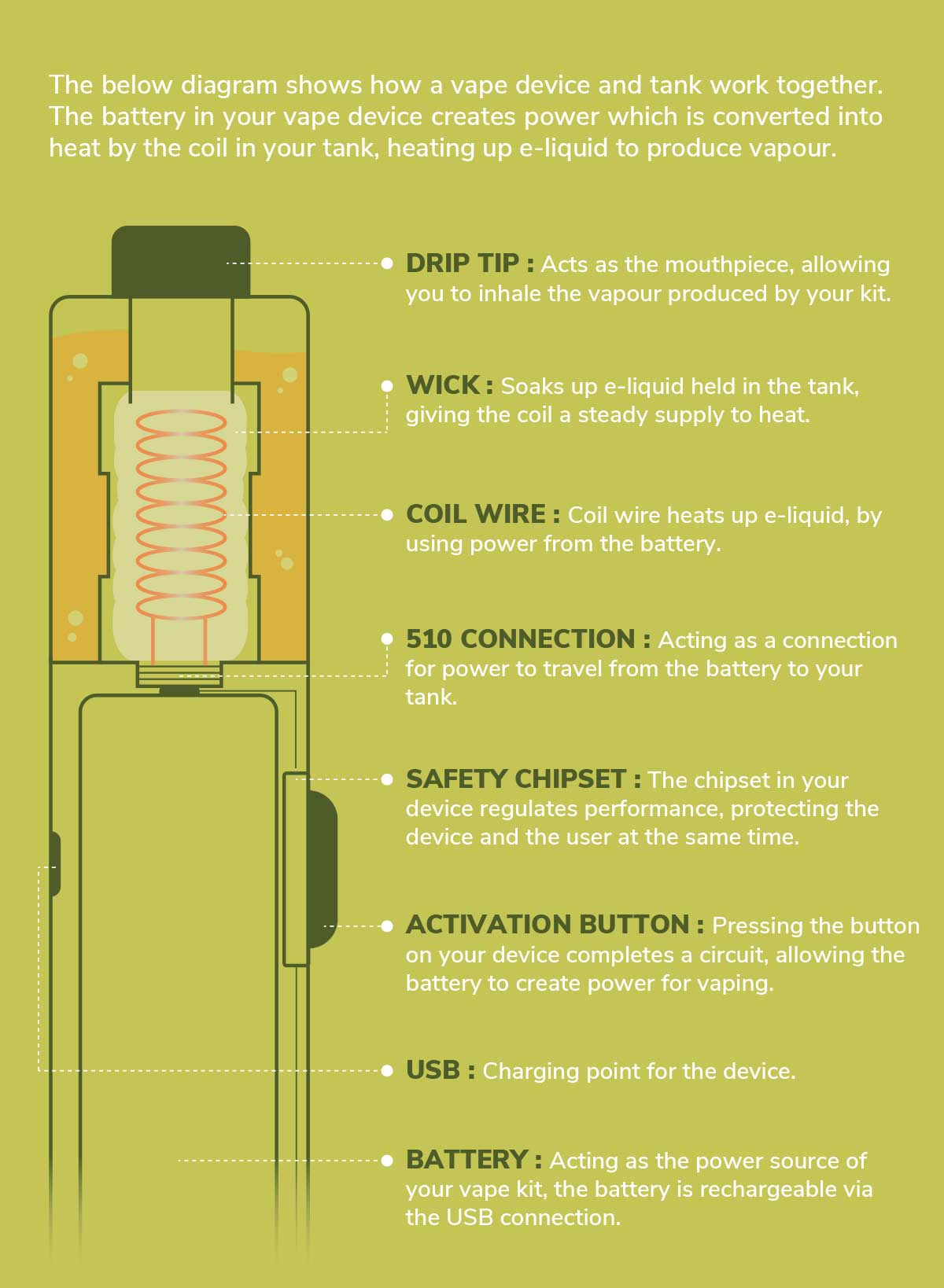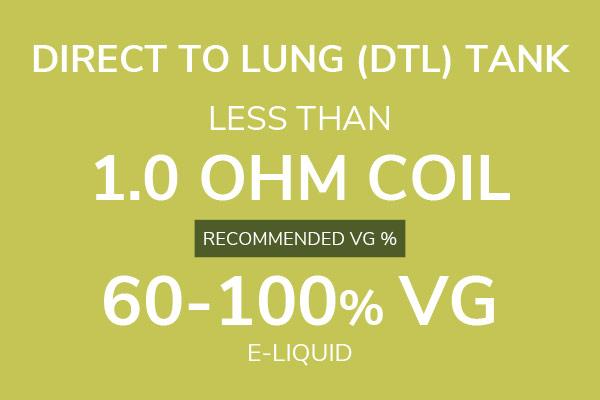The Ultimate Guide To Vape Tanks
Vape tanks are an essential part of the vaping experience, providing an outlet to heat e-liquid and create vapour production. Vape Tanks come in all different styles and sizes to suit specific vaping needs. Having a knowledge on vape tanks is essential to be able to be used and maintained properly.
WHAT IS A VAPE TANK
A vape tank is designed to heat e-liquid and create vapour, working in combination with a vape device. It is the vape tank that comes into contact with your mouth, they all have a tip or mouthpiece that you inhale on to draw in vapour. Tanks will hold up to 2ml of e-liquid which you will add yourself. There are plenty of vape tanks available, and you’ll want to pick the best one for you. This is easier than you may think.

HOW DO VAPE TANKS WORK
A vape tank contains what is known as a vape coil, it is the coil itself which heats the liquid you’ve added into the tank. A coil is made up of a piece of wound metal, it converts the power of the battery in your vape device into heat. Around this coil is an absorbent wick normally made of cotton, this wick soaks up the liquid held in the tank. The two components work in combination, with the wick supplying a steady flow of liquid for the coil to heat.

A chimney sits atop the coil and travels the length of the tank to the mouthpiece, meaning that when you inhale you can draw in the vapour that has been created by the coil. On the base of the tank you will often find an airflow slot, it is this slot that allows you to intake air as well as vapour for an easier inhale.
How Do Vape Devices And Tanks Work Together
A vape tank can't work on its own, it will need to be used with a vape device, often the two can be purchased combined as a vape kit. These are greatly recommended as they take a lot of the guesswork out of matching your tank to your device.
A vape device will contain a battery and regulating chipset, this battery acts as a power source which is needed to heat the coil in your vape tank, the chipset controls output and regulates the device. From this simple premise, a range of models have been created to suit a growing market.
VAPE TANKS AND COILS
Why Are There Different Types Of Vape Coil?
As we mentioned above, the coil plays a vital role in your vape tank
Manufacturers will create specific coils for their vape tanks and your vape tank will include coils, often pre-fitted. Information about their model and available replacements can be found in your manual.
That being said, manufacturers may create different variants of a type of coil for the same tank to help it perform differently, mainly to increase or decrease vapour production. Coils are separated into two categories - mouth to lung and sub ohm.
Whether you’re using a sub ohm or a mouth to lung coil, they will eventually need to be replaced, the cotton inside will deteriorate over time and will create a bad taste. It is this taste that signifies when it’s time to change coils. There are different wicks available, such as ceramic, they will also need to be replaced as build-up occurs.
What’s The Difference Between Mouth To Lung And Sub Ohm Coils
Coils are grouped by their resistance, which is recorded in Ohms. Any coil that is 1.0 Ohm or higher is classed as a mouth to lung coil, any coil under 1.0 Ohm is called a sub ohm coil. As a general rule, the higher the resistance the less vapour is produced, and conversely lower resistances will create more vapour.

VAPE TANKS AND E-LIQUID
As discussed earlier, vape tanks will need e-liquid to produce vapour. If your tank runs out of e-liquid your coils will only have cotton to heat up - which will taste awful. So remember to keep your tank topped up with e-liquid, 2/3 full will usually do the job. When you fill your tank for the first time we recommend keeping your tank upright for 5 - 10 minutes, allowing e-liquid to saturate your coil.
What E-liquid Do I Need With My Tank?
Pairing e-liquid with your tank is an important decision, it comes down to much more than just flavour. VG (Vegetable Glycerin) and PG (Propylene Glycol) are the two main ingredients found in e-liquid (along with nicotine and flavouring), they are also widely found in food and medicines.
Each e-liquid will contain a mixture of both VG and PG, always adding up to 100%. For example, 50% PG / 50% VG or 70% VG / 30% PG. PG is used as a carrier for nicotine and flavouring, while VG is used as a thickener allowing the liquid to be vaporised.
Thickness is the biggest decider on what kind of e-liquid you will need to use. E-liquid manufacturers can make their liquid thicker or runnier by changing the amount of PG and VG in their blends. The more VG an e-liquid has the thicker it will be, while higher amounts of PG will make an e-liquid thinner.
If you’re using a mouth to lung tank you’ll need a thinner e-liquid, one that is 50% PG or higher. Sub ohm tanks will require a thicker liquid, we’d recommend an e-liquid that is 60% VG or higher. This is simply because thicker e-liquids will require more power to heat them, this can only be accomplished by a kit that uses a sub ohm coil.


What About Nicotine?
You should now have a good understanding of what VG/PG e-liquid you need, you’ll also need to pick a nicotine strength. To suit different levels of craving there are different nicotine strengths available - up to 20mg. When it comes to picking your ideal nicotine strength, a good indicator is to base your choice on how many cigarettes you smoke per day. You can use our handy chart below.

WHAT ARE THE DIFFERENT TYPES OF VAPE TANKS?
All vape tanks have certain similarities, they must all hold up to 2ml of e-liquid (as legislated by UK law), they will all contain a coil of some kind and they are all designed to vaporise e-liquid. To suit different vaping styles and experience levels, there are now a range of vape tanks to choose from.
Mouth To Lung And Direct To Lung Vape Tanks

Just like coils, vape tanks are split into two broad categories - mouth to lung and direct to lung. Both of these are references to the style of vaping the tank will support. A mouth to lung tank will enable you to draw vapour into your mouth and then breathe it into your lungs (much like you would a cigarette), these tanks produce a smaller amount of vapour to accomplish this. Direct to lung produces a far greater amount of vapour, supporting a style of vaping where you inhale the vapour directly into your lungs and then exhale.
What Are Sub Ohm Vape Tanks

Essentially these are usually the same as a direct to lung vape tank. A sub ohm vape tank will use a coil that is below 1.0 Ohm in resistance, because of this it will create larger amounts of vapour, suiting it to a direct to lung vaping style. It is not uncommon to see a sub ohm tank called a direct to lung vape tank and vice versa so don’t be confused.
What Are Rebuildable Atomisers

Only ever recommended for the advanced vaper, rebuildable atomisers represent the pinnacle of custom vaping. These tanks enable you to build and mount your own coils, you will choose what metal type, what resistance and what size your coils will be. The result is a tank that performs exactly how you want it to, but in order to use one safely and effectively, you’ll need a good knowledge of vaping, Ohm’s law and battery safety. You can find more information on rebuildable atomisers here.
I’M NEW TO VAPING, WHAT VAPE TANK DO I NEED?
If you’re new to vaping you’ll be an adult who smokes, we never recommend vaping to anyone under the age of eighteen who isn’t already a smoker.
When you’re making the switch you're going to be drawn to something that’s familiar and relatively easy to use. A tank that replaces smoke with vapour, which produces a small amount of cloud, just like your cigarette would produce a small amount of smoke is the recommended place to begin. If you start off using a sub ohm vape kit you’re probably going to find it rather unusual and out of your comfort zone, which essentially can put you off the whole thing.
Simplicity is key, there are advanced vape kits and they have been designed for a very specific market - advanced vapers. These are people who have been using the equipment for an extended period of time and understand the nuances of wattage control, vapour production and other things that just aren’t that vital to know when starting out.
When you pick your first vape kit or tank, we recommend something simple. The best example is a top-filling mouth to lung tank, which uses coils that are above 1.0 Ohm of resistance. This is perhaps the most popular type of vape tanks available so you’ll have plenty of options to choose from.
SUMMING UP
Picking a vape tank is much easier than you may think, it just comes down to knowing what you want. Remember you decision should always be based on your experience level, how much vapour the tank will produce and what you will feel comfortable using. The last is perhaps the most important, remember if you don’t feel comfortable with our device, you won’t keep using it
We hope this guide has helped and for more information on vape tanks, or vaping in general - please contact us directly.


